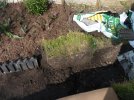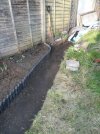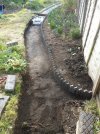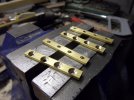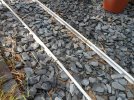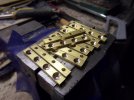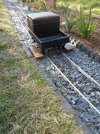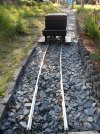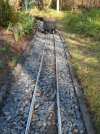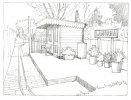Two out of three negative tests at last, but playtime is not only restricted by a sensible bit of extra isolation, but by snowstorms too!! It therefore seems to be an opportune time to start planning the junction points while cosily ensconced in the warm.
I might well be setting us up for a fall with that plastic "Ground textile" path material, (mainly by not knowing how long it will survive) but from the moment we decided to use aluminium rail it has been our intention to lay some proper, timber sleepers for the tight curve and return loop line at the top of the garden. Conventional construction of the points was an absolute no-brainer!
With those objectives in mind, we have already acquired several bags of a hard, crushed stone ballast, carefully selected to be of a similar colour shade to blend with Mr. O's slate chippings.
Some concern about the insertion of a set of points midway along the main footpath, with their converging rails and transverse timbers being a bit of a slippy-trippy hazard remains a tad vexing! My personal preference would be something perfectly prototypical:
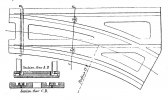
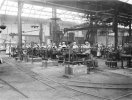
(Copyright images shown for illustrative purposes only)
Throughout the entire Horwich Works, all the points and crossings were to the same standardised, cast iron, tram plate pattern, regardless of the location and type of running rail attached to them. Providing something similar would undoubtedly solve almost every issue in our situation - even if it might look a little odd?!
At far as I can see, both technical and financing difficulties somewhat outweigh any hoped for benefits though?
It would be too easy ending up worrying myself to a complete standstill, so for the time being anyway, I am proceeding along rather more practical lines...
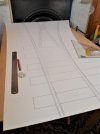
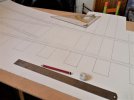
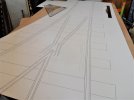
Never mind that new fangled Templot (sorry!) - this is more like Tem
plod ?!
I had already started this drawing, just before my wretched confinement, by bending the two outer rails to the desired radii and then tracing out onto a very large and unwieldy sheet of mountboard. The fun since then has been stooping (sometimes slumping?!) over and trying to fill in all the rest of the jolly geometry!
Hand building P&C work in flat bottom is always a bit testing, but 16mm scale in brass - with cheating solder joints - was a walk in the park by comparison with this monster!
Way back then, I only needed to buy some lengths of the same hardwood strip that was used by Brandbright and Tenmille for their plain track systems in order to seamlessly match mine up! This time around, I was not at all sure what size timber would be remotely suitable for riding on?! Searching on line guarantees bewilderment for me - and am usually rather sceptical about the advice of many "experts" to be found there. Not being able to visit a shop and sample the wares, I was thus restricted. One guy on his website recommended treated roof tile batten for 5 inch gauge, so something on that order might possibly do?
I found a four foot length in our dining room, you know; just as you do?!
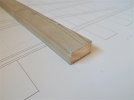
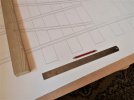
The facts that that nobody knew quite where it came from, or indeed lay claim to it, I was happily able to use it!
Now here is where the strange became stranger:
As already mentioned; the curvature and leads of the point had been established first, followed later by the dimensions of the found wood, determining the precise location and spacing of timbers under the nose of the crossing and the point blades.
The light weight of the 16mm rail does slightly limit the bridging gap between the sleepers, so I randomly chose 60mm - on the basis that it sort of looked about right, but with an absolute certainty that there was no way that they would spread out evenly - with much fiddling required to fit?!
I was gobsmacked when discovering that the fit was
exactly four !!
After completing the marking out, and then standing back for an overview... an odd thought suddenly occurred...
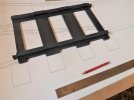
Now that's not just a bit weird, that's
really spooky innit??!!
Pete.
I note what appears to be a complete absence of sleepers, or, indeed, any mention of how the rails are fixed down (I can see screws, but screwed into what??) or held to gauge.



